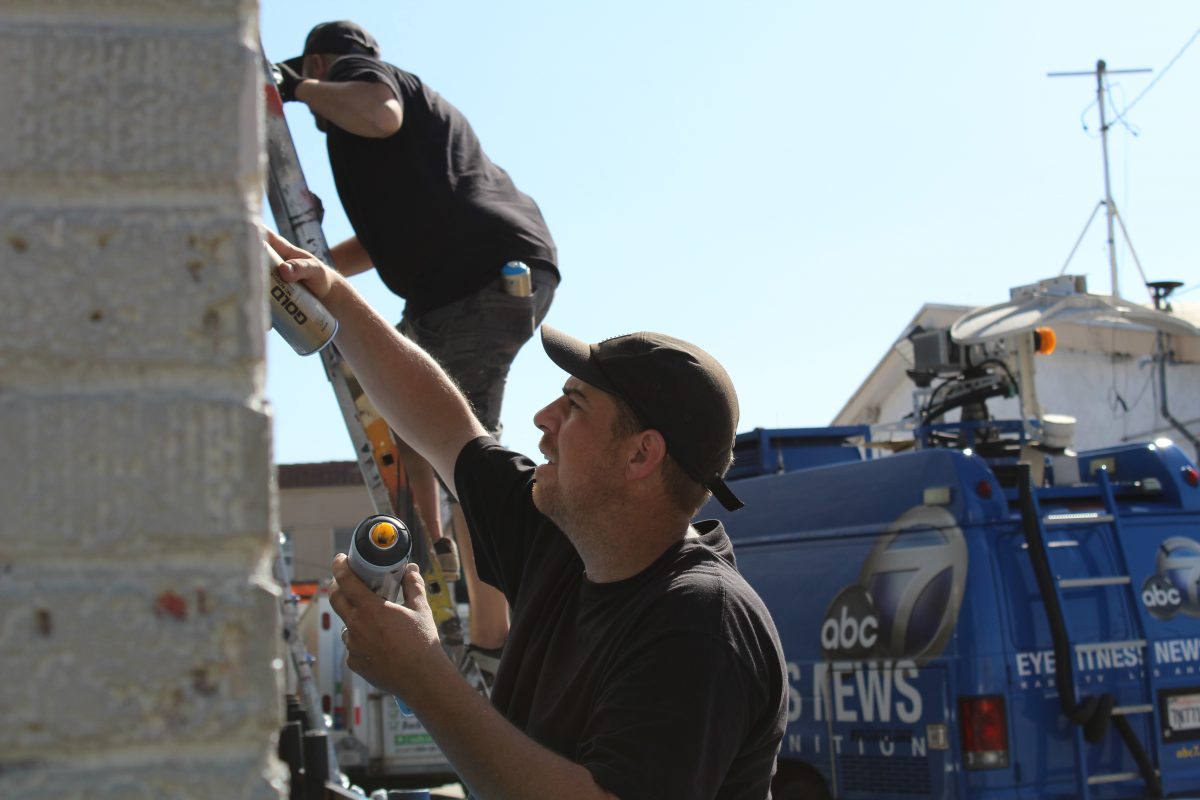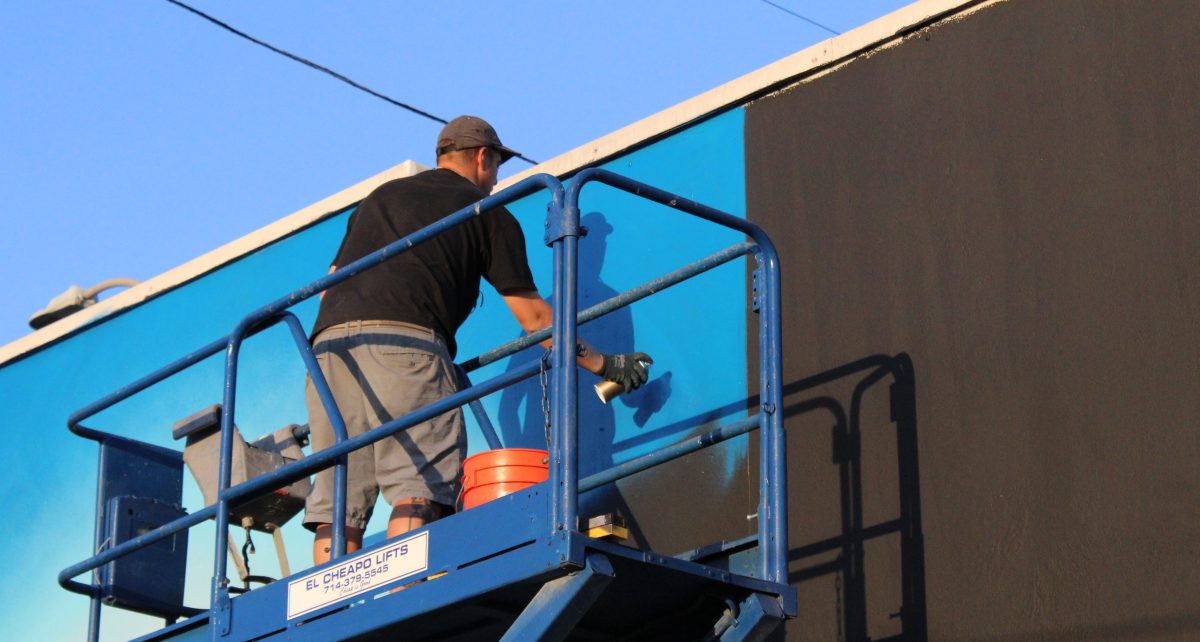Los Angeles is an iconic city, but it never quite feels like it lives up to any sense of beautiful grandeur, the architecture is more post-modern than historic, the sun bleaches so many of its surfaces that there is always a sense that it has been washed out, and the sprawl makes it hard to contextualise your location. But despite this, there is an undeniable quality to the various haunts, whether it is the air of Hollywood Boulevard, the familiar locations from film and television, or the eccentricities of Venice Beach. The wide streets and the open expanse above give it feeling not dissimilar from post-quake Ōtautahi, although on a completely different scale. So when we were recently in the city, there was an unsettling melange of familiarity, strangeness, expectation and reality. But, for all that, there were lots of artistic treats to discover, from large murals to smaller interventions, with some big names thrown in the mix. It is impossible to cover all of such a sprawling city, and even the places we did explore are often hard to fully navigate, but here are some favourites we did find. Dive on in and check out some of our highlights from the City of Angels…
Continue reading “Postcard from L.A.”Tag: Los Angeles
And That Was… September and October, 2024
Oops, we did it again – you get another two-for-one this time as our busy schedule kept us a little behind the eight-ball when it comes to our favourite things! It might be a little concerning, what with a bumper summer incoming and a heap of cool projects on the horizon – but fear not, we make a promise to be very, very good. We hope. But enough with the apologies, let us celebrate what has been a prolific period with some highlights! Here are the things we loved over the last couple of months…
Continue reading “And That Was… September and October, 2024”Dcypher – Homecoming (Part Two)
If you have been following our interviews, you will know that we like to go in-depth, and that sometimes (okay, it is a pretty regular occurrence) we need to split our conversations into two parts. When it comes to Dcypher, that was always going to be the case. Based in Los Angeles, we not only had to make the most of the chance to catch up while he was in town, but it was also always going to be an inevitably wide-ranging discussion based on his lengthy experiences. After covering his recent projects in Christchurch and his move to Los Angeles and the necessary work to re-establish himself in a new scene in the first part of our interview, in the conclusion of Homecoming we pick up on the realities of making a living as a full-time artist in Los Angeles, being close to the emergence of ‘blockbuster’ graffiti and street art exhibitions and the responses on the streets, how he keeps an eye on the street scene in Christchurch, his experiences painting in different cities, and his plans for the future…
How do you make a full-time career as an artist in Los Angeles? Is it a mixture of jobs, or are you able to be selective about what you do?
Yeah, well I’ve always looked at myself as more of a commercial artist. As I’ve grown over time I’ve always tried to adapt to certain jobs, to find ways of making money and that kind of thing, which isn’t always a lot of people’s drive as to how to go about it. It is a tough one, it does sort of change how you’re going about things. You have to take a step back and let other influences come in and whenever you’re doing work for whoever it might be, it’s always going to differ from your own personal work to a certain extent. I mean, a lot of people have figured out how not to do that, but it’s a tough gig to stick to your own thing and that’s all your going to do, you know?
You touched on how hard it was at first to be in L.A. and to create networks, to find opportunities. Do you think that in a bigger city it is in some ways harder to at least break through, because the pool is so much larger and more competitive?
No, I think the opportunities in a bigger city are far greater, and you can kind of pigeon hole yourself a little bit. But, being an outsider also kind of helps in the fact that you can navigate and come in from a bunch of different directions, meet various people and have people approach you and that sort of thing. So, yeah, I think it has definitely opened the playing field a lot more being in a bigger city and approaching it in different ways, you know, I commend folks who can pull that off…
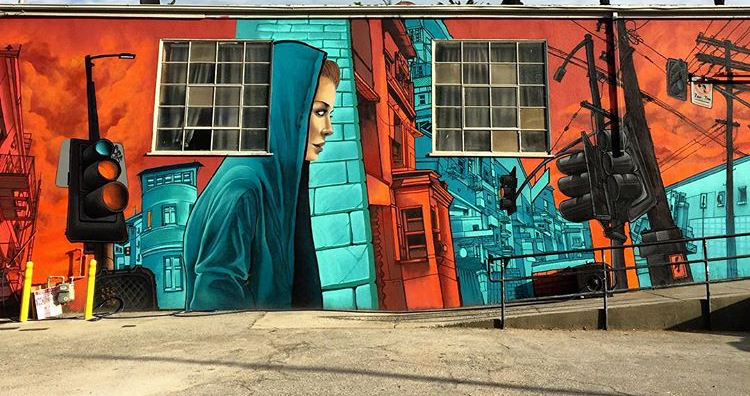
Obviously in Los Angeles there’s the longer history going back to the Latino gang graffiti, which pre-dates the graffiti that grew out of Philadelphia and New York, and then there is the emergence of hip hop graffiti and how it evolved in the area over decades, there’s the famous Saber Los Angeles River piece for example, these all give the city a significant place in the narratives of American graffiti writing culture. Recently, the city has become a setting for some organised reflection on those histories, notably the staging of the Art in the Streets show at the Museum of Contemporary Art in 2010, and now Roger Gastman’s new exhibition, Beyond the Streets, both of which have been pretty massive shows…
Yeah, they are huge for sure…
They both deal with broader urban art histories than just graffiti, which makes them interesting presentations, but simply in terms of their staging in Los Angeles, do you think it is as much to do with the importance of the city in these cultures, or is it more that ‘blockbusters’ are what L.A. does?
I think it’s a platform where, or it feels like it’s a platform where a lot of people can sort of come in and almost change the history in a lot of ways, and put people in a spotlight, people that might not have necessarily put in a lot of work. If you listen to the street, a lot of these guys weren’t necessarily the guys who were doing it, and there’s a lot of guys who get salty when they have been doing that shit for years and they have stayed true to the whole thing and been left out, because there are so many players in the game, you know what I mean? It comes down to how good you are at navigating the gallery thing, if that’s your M.O. There’s shit loads of guys who never get credited, who have done fucking insane amounts of shit, amazing work over the years, but have stayed underground and never really been put in the spotlight in that respect…
I was going to ask about that, what the ground level reactions were like… I remember reading that people were upset at how Art in the Streets favoured certain stories and as you say, left certain people out, so that was the feeling you were getting in Los Angeles?
Yeah, definitely. I obviously know a bunch of guys that weren’t involved but who should’ve been involved, guys who put in years and years of work. But it kind of just comes down to what groups you associate with and whether they are getting play or not. But everyone’s trying to do their own thing, and everyone’s got their own way of going about it and making their own stamp in history, some just sort of stay true to the game and keep it like, underboard, as opposed to above board…
It’s an unavoidable problem for any show of that nature. You are talking about too many diverse voices and participants to ever ‘get it right’. Also, once you start bringing in so many other influences, like the gallery worlds, and the new mainstream status of a number of urban artists, things evolve even further. Curating and condensing these histories is essentially impossible, right?
It’s always going to be the case. A famous New York graffiti writer once said: ‘Everyone has their own history of graffiti.’ No two peoples’ history of graffiti is going to be the same. To some extent, history is written by the victors, you know what I mean, so whoever is on top can kind of claim the history so to speak. Which is cool, you know, that’s part of it, but there are so many people doing their thing that there’s a million different versions of it…
In his book The History of American Graffiti, Roger Gastman recounts that he was told by someone who didn’t want to participate: ‘Anyone who tries to tell you the history of graffiti is either a liar or a fool.’ (Laughs)
I would totally agree with that.
We briefly touched on returning for Spectrum, but coming back now over the ten years you have been away, particularly post-quake, what is your take on what’s happening on the streets in Christchurch? Do you like to take a pulse of what is going on, or is it sometimes too hard to do that, especially if you come back for specific commissions that keep you occupied?
No, I always take a drive around and take some walks to old spots and stuff every time I come back to see what the next generation is doing. It’s awesome to see that people are still out there bombing and tagging, because that’s kind of like the essence of it all. And obviously with the earthquakes, it’s opened up a bunch of opportunities for both illegal stuff and legal stuff, which is cool, because I think they kind of should exist side by side to some extent. But as time goes on, it’s always something that’s going to be apparent, and there are a bunch of guys taking it very seriously which is good to see, and obviously getting away with it. (Laughs) It’s kind of something that gives the city a little bit more life, that’s the way I see it anyway…

Following that period where the central city had a sense of freedom and there were a lot more spaces to explore, it now looks like those traditional spaces are becoming more popular again, back on the peripherals. Many of those empty buildings right in the middle of the city are slowly disappearing, but it does seem as though it has created a bit of a new energy in the writing scene with new generations. It’s interesting when you think about the different generations of Christchurch writers, and I guess you guys were maybe what, the second or third generation? If you classify it loosely…
Ahh, yeah, you are probably right there…
And now I guess there’s like another two layers or more on top of that, and its starting to build this sense of history, do you sort of feel like, even living overseas, you are seen as a something of a respected, veteran figure?
Yeah, I guess so. There’s not just myself, there’s a bunch of other people, that would be considered respected figures, but I guess I’m someone who has sort of taken it a bit further than other people would have be able to, just being in Christchurch itself. But yeah, there’s a bunch of other guys that are definitely respected figures. I do get hit up by younger generation dudes trying to paint walls and stuff, they are obviously smart enough to realise that if someone has been doing it for way longer than you have, you can learn something from them, you know what I mean? At the same time, I always try and stay humble with what I do, because I’ve been lucky enough to travel and see the amount of work that other people have put in round the world, what it really means to be revered… and being from the bottom of the world, to put yourself in that context is tricky…
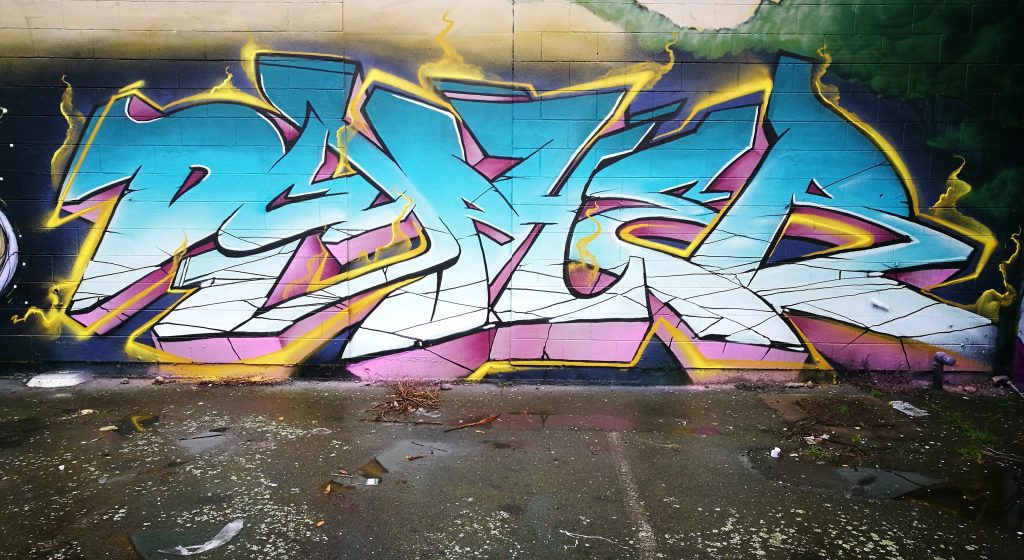
Although, there are a number of New Zealand artists who are killing it, travelling the world, do you feel like there is more potential for people to be able to have that global success, to make a mark internationally rather than just locally, even while still being based here? There are multiple options now, you can move, you can stay, you can travel, you can even make a living here, there seems to be more choices than ever before…
Yeah, definitely. I think it is quite easy to get to a point where you feel that you’ve outgrown your environment to some extent, and the amount of opportunities that are available in New Zealand are still somewhat limited, and people are trying to branch out and do stuff in other countries and what have you, but at the same time you’ve got to remember where you’re from and try and bring it back full circle too…
In your case, you get to experience living in another city, and all that comes with that, including a level of home comfort, which is different to living out of a suitcase, which is the reality for a number of artists now, travelling between projects, festivals, events. I imagine that must get somewhat tiring at a certain point, although I’m sure its also an exciting way to live…
Yeah, being grounded in one place can give you a way better perspective of whatever that city might have to offer or whatever, but if you’re lucky enough to be able to travel and live out of a suitcase, that means you are doing something right…
For sure…
Even in visiting a number of cities in quick succession, you’re going to learn a shitload about being a fucking human, you know? (Laughs)
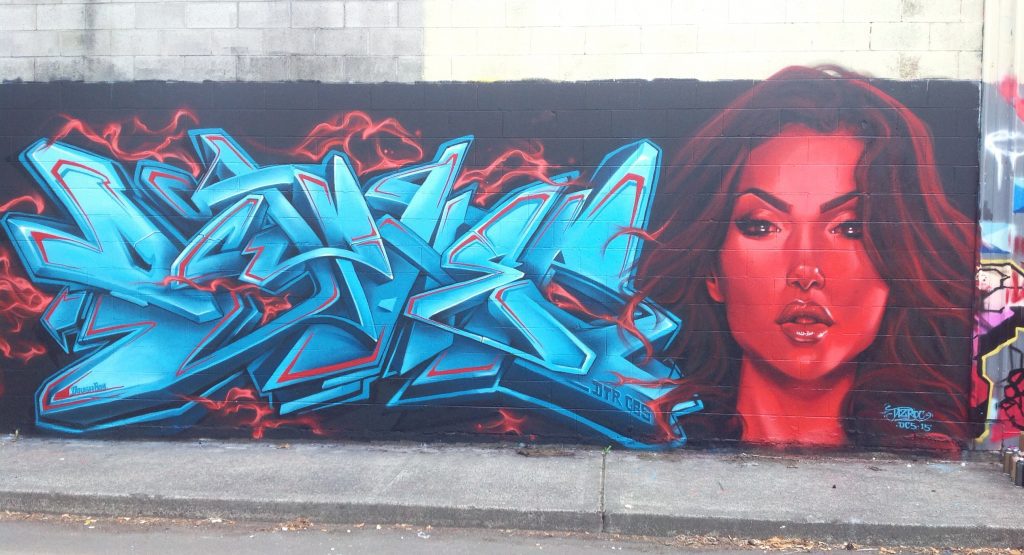
Yeah definitely, you can’t help but be influenced by the places you paint, from the people you meet, to the physical environment, to the actual experience of travel itself, the journeys to get places, all those elements that come into it, they must all build up and inform your work…
Yeah, even being based in L.A., I still try and travel, to paint at festivals and do work across the United States. The States is a crazy place, where all the cities are so different, it’s insane. Like, you think you have Americans wrapped in a nutshell and you really don’t, you go to New Orleans, or you go to Seattle, you’re in two different countries!
What specific cities have you enjoyed painting in the most?
I mean, just painting in Los Angeles the most, makes it the most exciting place to paint. But I’ve painted in Albuquerque, Seattle, New Orleans, San Diego, and a bunch of other places, more so on the West Coast, and within the left-hand side of the United States. It’s awesome, it really gives a good perspective on that country, and again, the regional styles of all those places. But it’s somewhat interconnected as well, people are building bridges and making things happen between cities and getting influences and styles and techniques, what have you, from city to city, which is cool. Somewhere like Florida, where they have Art Basel and festivals and shit like that, is a fucking crazy place. There is a lot of crazy shit going down there. I was there painting a mural for Art Basel, and literally within like one hundred and fifty feet from where we were painting, there was a little gated neighbourhood where all sorts of crazy shit goes down. Some kid was shot at like five o’clock in the afternoon for his headphones, while one hundred and fifty feet away there’s hundreds of people painting and doing their thing and they’re not really part of that environment, but that environment still exists. There’s a lot of crazy shit going on in these tiny microcosms in the United States, it can be a dangerous place…
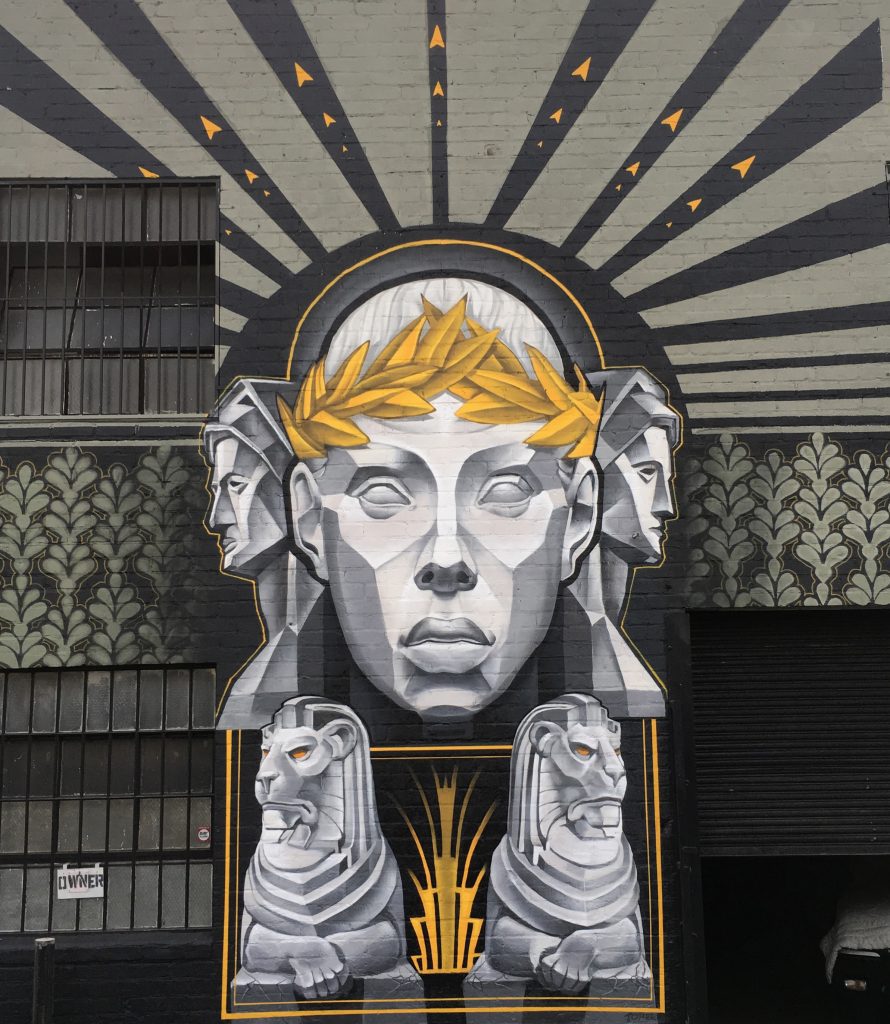
Living in the U.S. for almost ten years, do you feel like a Kiwi who lives in L.A., or a Los Angeleno from New Zealand?
Yeah, definitely a Kiwi who lives in LA. I’ll never renounce my ‘Kiwi-ness’! I’ve always tried to uphold the fact that I’m a New Zealander, I would never pretend to be known as an American in any way shape or form, even though I’m a citizen. The guys I paint with, the CBS guys, nicknamed me ‘Big Kiwi’, and I can never live that down, so, I would never consider myself a Los Angeleno. But a lot of people do, and it doesn’t take long for them to consider themselves Los Angelenos, even if they’ve only been living there for a couple of years, which is interesting. It’s such an amazing place where a lot of crazy, interesting things are going on…
I feel like with a place like Los Angeles, it would be easy to get swept up in the romanticism of it, and to identify with it…
People want to attach themselves to it and you will meet someone and ask: ‘Are you from L.A.?’ They’ll be ‘Yeah, totally, but I’m from Ohio originally…’
We kind of grow up with Los Angeles and New York as these iconic places, the settings for so much of our popular culture diet, that we have this expectation of them before we even visit, which might make it easier to adopt that identity when you do get there…
Yeah, I think, maybe your preconceived ideas of what a city has to offer are always wrong, like you always get to a city and it’s like: ‘Shit, this is not what I expected!’ A place like the United States is so diverse, so much crazy shit is happening constantly, it’s easy to align yourself with a certain aspect of the city, rather than a general idea of what that city sort of stands for…
Coming back relatively regularly, and maintaining that public profile through walls and projects when you do, have you ever thought about coming back and staging an exhibition in Christchurch, or actually just moving back?
Yeah, I just recently had a daughter so the idea of living in the United States for the rest of my life is sort of diminishing. You always want to have your kids experience life the same way you did to some extent, and schools and stuff in New Zealand are a little bit better than central L.A., so yeah, I definitely always considered coming back and producing work back home…
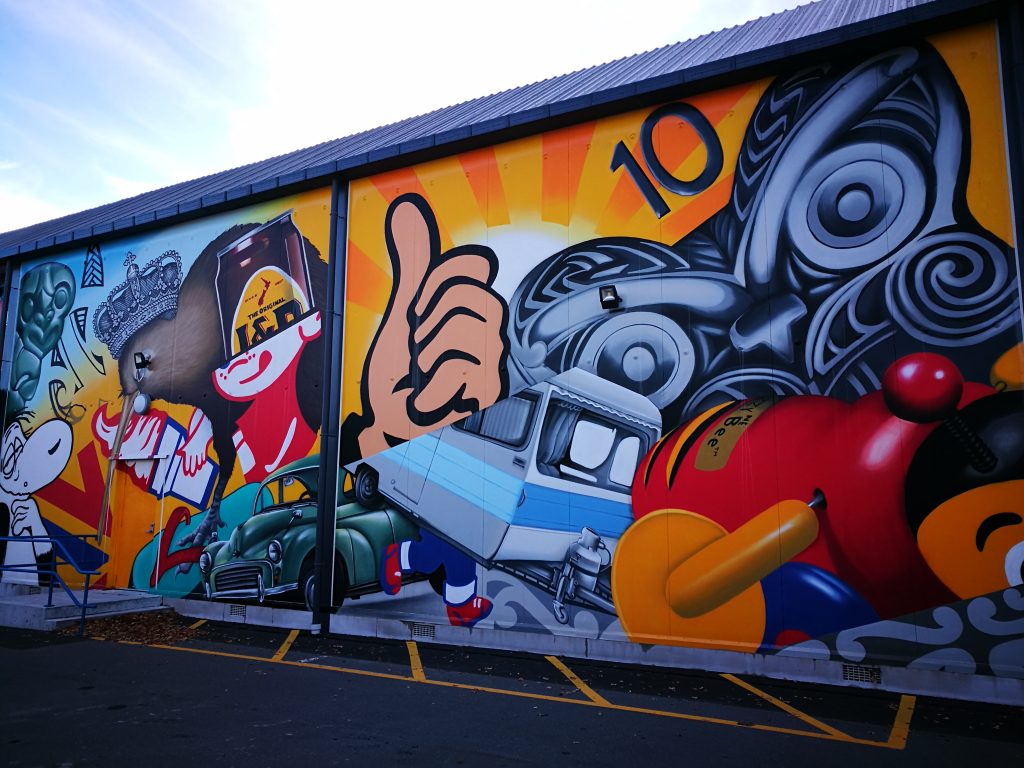
You were part of the surge of graffiti culture in the early to mid-2000s, with the likes of Disruptiv, the popularity of hip hop summits, and even locally, you were part of Project Legit, and a number of other projects as well, do you kind of feel like there is a similar vibe now, albeit with this evolved concept of ‘street art’ and whatever that entails? It must feel like coming back and doing those types of things is actually achievable, not only because of the things you’ve learned in the ten years you’ve been away, but because of the environment you are coming back to as well, right?
Yeah, definitely, I think everyone here has been keeping the ball rolling, you know. When you move away you feel like nothing’s happening back home because you are so inundated with your own life…
Out of sight, out of mind…
Yeah, but every time I come back, I’m sort of floored by the amount of stuff that’s going up, different people really pushing the artform. So, I’m super stoked to be able to have that in my mind, that it is a possibility to move back and try and make something happen. Although, it is kind of daunting as well because the work opportunities in the States are far greater, whereas here you’ve got to hustle that little bit harder to try and get things going. But I feel you could, but that’s a period where you start to refine your thing and really nail it down.
Thanks for sitting down with us man, safe travels and see you back…
Yeah, cheers man…
Even though Dcypher is back stateside for now, you can keep track of what he is up to through his various online forums:
Facebook: @dcypherart
Instagram: @dcypher_dtrcbs
Web: https://www.dcypherart.com/
Dcypher – Homecoming (Part One)
Dcypher has been living in Los Angeles for a decade, but the Christchurch-bred artist has still made a significant contribution to the post-quake city’s walls. From commissioned works such as his cut-up patchwork of iconic kiwiana on the Wharenui Pool in Riccarton, or his on point ‘Welcome to Christchurch’ greyscale postcard for 2015’s Spectrum festival, to more informal jams and productions with his DTR crewmates, he has made the most of his sporadic trips home. Dcypher, of course, has pedigree, he is not some out-of-towner drawn to the opportunities in Christchurch, but rather an important figure in the city’s pre-quake graffiti history. Dcypher’s legacy now extends across decades and geographic settings, tracking the progression of an artist across the globe, and the transition between graffiti traditions and the new mural renaissance. Prior to heading State-side, Dcypher had already developed a notable local and national profile. From his role as a tutor and artist for Project Legit in the early to mid-2000s (an art programme that served to mentor young graffiti writers and provide legal opportunities for painting), and numerous local projects and commissions, to his regular inclusion in issues of Disrupt Magazine and even Askew’s 2007 book InForm, where, alongside Lurq and Pest 5 (although the latter had relocated to Auckland by that time), he was one of the few featured artists from outside of the North Island, Dcypher was able to fashion something of a career from his graffiti roots, a transition that might have been unexpected, even amongst the graffiti culture renaissance of the mid-2000s in Aotearoa. However, when he left Christchurch for the United States in 2008, he, like most people, had no idea of the monumental changes the city would endure just several years later, and indeed, the creative opportunities that would emerge in the recovery period. As a result, Dcypher has been returning to a different city, not only from the hometown he left behind, but also in comparison to the sprawling and stretching metropolis of Los Angeles to which he has become accustomed. That environment, coupled with the wisdom of experience developed over years of work, has ensured Dcypher’s output expresses a well-honed practice, striking and crisp, distinct but ultimately indebted to graffiti as the culture from which he emerged, a balance he continues to maintain. While he was recently back in town, I sat down with Dcypher to find out about his views on Christchurch’s current scene, his experiences as an artist abroad and what his future may hold. While the open-air setting of Smash Palace may have made the difference between mid-winter Christchurch and bright Los Angeles abundantly clear, it was obvious that while the man might not reside in Christchurch for now, he maintains deep connections to the people, places and unique characteristics of his hometown.
You have been back in town for a couple of weeks now, what have you been up to since arriving? From all accounts you pretty much hit the ground running…
I started the Lyttelton skate park mural with the rest of the DTR crew, Ikarus, Yikes and Wongi, pretty much a few days after I arrived, and that took about eight straight days of just painting. The weather was good though, and everything worked out. Then I just got straight into the Airport mural with the Oi YOU! guys, George [Shaw] and Shannon [Webster]. That was a good fucking two weeks of straight work. I think George added up five hundred hours or something, so, we had all of us working on it. It was all acrylic, which is pretty much the first time I’ve ever done like a full acrylic mural, so it was a learning curve for me. But yeah, the result was good, and yeah, I have just been trying to relax after that.
So, when you say acrylic, you mean with brushes rather than cans?
Yeah, brushes, rollers, trying to learn new techniques for fading without spray paint, that kind of thing… But mostly, yeah brushes and rollers.
Was that just a condition of working at the Christchurch Airport, because the mural is located inside the actual building, right?
Yeah, obviously with all the passengers and commuters within the airport, they can’t have spray paint fumes going about the airport, so they were pretty adamant about just keeping it all acrylic.
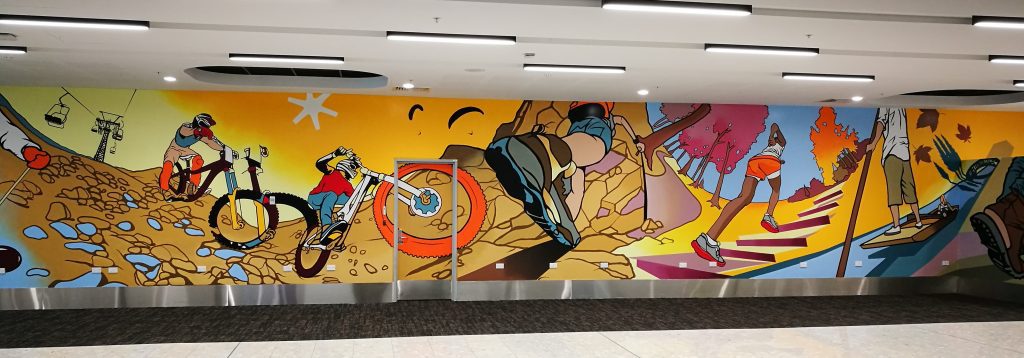
Having made a career out of wielding a spray can, did it take a while to get your head around the brushes and rollers? Using a can would be second nature now, and you mentioned having to work on fading techniques, did it impact your stylistic approach as well?
Yeah, I had an idea that it was going to be the case, so I designed the mural with that in mind; using various techniques with acrylic paint to achieve the look I wanted. But in knowing that I was going to use acrylic paint, I had to design it and sort of tone it back a little bit and keep it quite simple, which isn’t necessarily my kind of style. The style that I chose was also something that I knew the Airport and the general public could palette. So, I guess it’s not necessarily my most interesting work in that sense, but it was an awesome learning curve to be able to use acrylic. I mean, I guess we’ve always used acrylic paint from the get go alongside spray paint, so I’ve always had an ‘in’ on how to go about it, and I’ve always tried to mess around on canvasses and use acrylic paint on a smaller scale where it makes sense to use brushes. Spray paint only works down to certain scale…
I was just going to say, it’s kind of the opposite of cans, they are easier to go bigger, whereas with brushes, it’s easier to go smaller, although obviously rollers help with larger works as well…
Yeah, but just seeing what a lot people have been doing overseas, especially in Europe and stuff, as murals get bigger and bigger, people are starting to shift to using acrylic with brushes and rollers on that really large scale. It is actually easier to use acrylic paint than spray paint; it’s cheaper, it goes further, it’s faster, the longevity is better…
A lot of people I’ve talked to have mentioned environmental concerns as well, not completely moving away from can use, but it seems to be something people are wary of…
Yeah, I think, if you were an artist that had the opportunity to be able to do that, then that would be cool. But I think it is probably not really an environmental thing, it’s more of a technique thing, just because best results are the end goal, you know what I mean? And environment is secondary, like everything else that humans do! (Laughs)
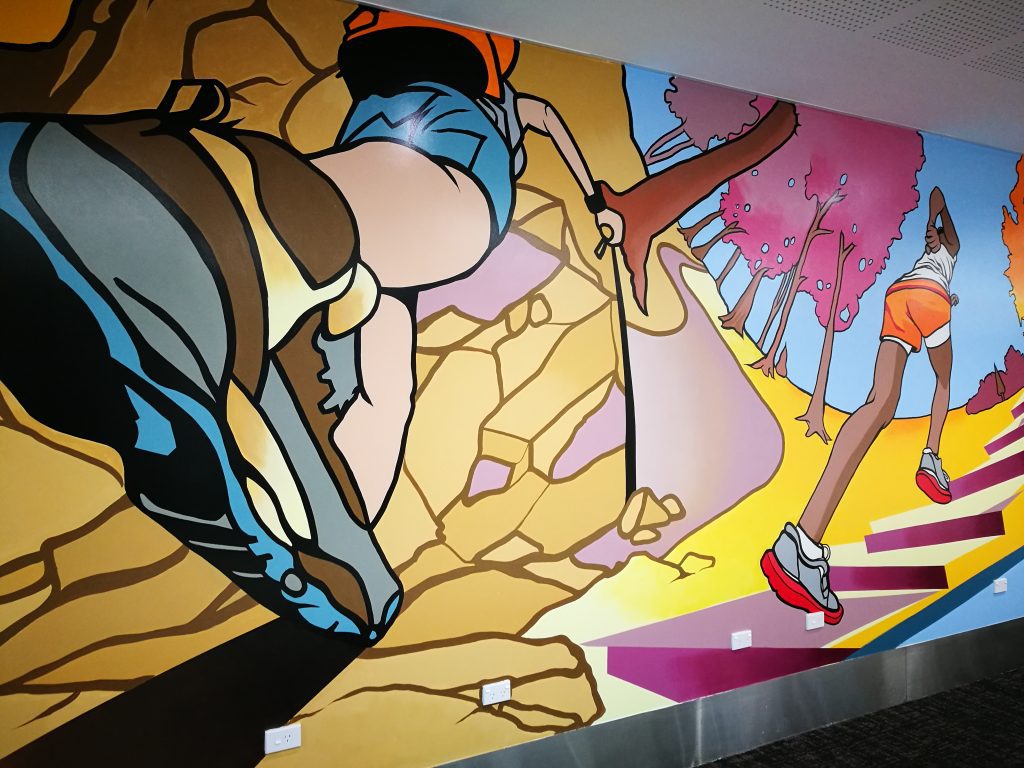
I guess as well, the evolution of this contemporary muralism movement into its own beast, it means you are getting artists from different backgrounds now, you aren’t necessarily coming from a graffiti writing background or even necessarily that aerosol experience. Mural artists are increasingly switching between streets and studios, combining those two worlds, like, I think of the Spanish artist Aryz, as a prime example of that sort of approach, he is definitely taking muralism into a painterly direction…
Yeah, that’s who I was referring to before. That guy is definitely the best muralist by far at the moment. And he was doing a lot of that stuff with rollers and brushes, ten years ago, you know what I mean…
To see some of the latest stuff he’s been doing, it literally looks like a studio painting on a massive wall, the painterly quality brings a totally different element to it…
For sure…
You mentioned that the Christchurch Airport mural came about through Oi YOU!, you have developed a pretty good relationship with George and Shannon over a couple of projects, beginning with your inclusion in the first Spectrum show (at the Christchurch YMCA in 2015). What was it like for you coming back for that show? Experiencing something like that in your hometown, and having some international context for festivals and events, was it easy to get on board with what they were doing?
Yeah for sure, they totally went about it the right way. They could have just had international artists of a high calibre come through, but by also involving local artists to do their thing, people who have set their feet in the city, a long-time before they arrived, it showed George and Shannon understood having that as an important part of it all. Those artists being represented in the festivals was a strong point to get across, that there are people that have been doing it in the city for a long time before this stuff had come about…
Witnessing, and of course contributing to (as one of the headline artists) that Spectrum show as it came together, and thinking back over all the years growing up in Christchurch, were you still taken aback that it was actually happening in your home town?
Yeah, I always feel like whenever you leave somewhere, awesome things happen, and you feel like you are missing out! (Laughs) I was just stoked to be invited back to produce work. I could have been overlooked, going off and doing my own thing, so definitely, it was awesome to get involved and to have that event and be a part of it all…
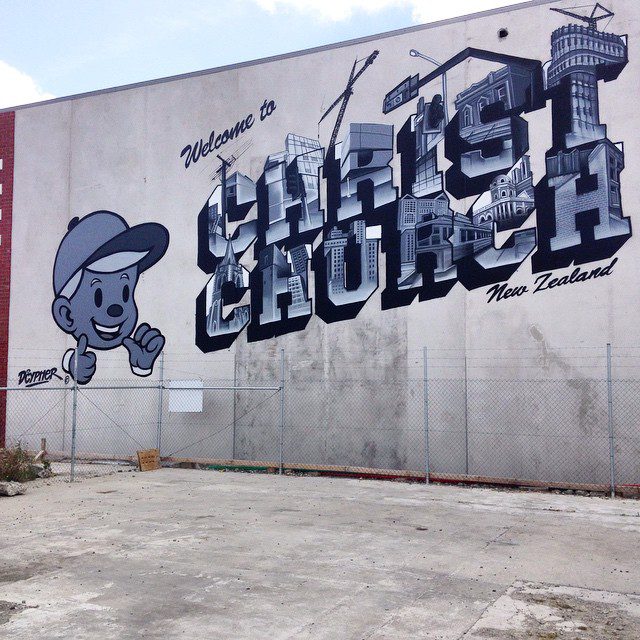
It must have been cool that all the DTR crew were involved as well [the exhibition even featured a DTR colab room, with portraits of the members in a darkened room]; to have that collective recognition as a crew as well as individually…
Those guys were all involved from the get-go, George got them all involved, I just kind of came in from the side, off the back of all that, which is cool. But yeah, it is awesome that they have been able to give an amazing amount of people opportunities to produce work and that’s kind of the essence of the whole idea and how it should go down…
As you said, the first thing you did when you got back this time was the Lyttelton skate park project with the rest of the DTR crew. You guys have a pretty lengthy history in the context of New Zealand, and Christchurch graffiti history, how is it getting back and painting together? Is it a different type of relationship than you have with CBS, your Los Angeles crew?
Yeah, you know growing up with a bunch of guys and painting regularly, there’s probably a little bit more of a brotherhood sort of thing. In the States, there are so many players that it’s a huge family and it can be hard to make those same types of connections. So yeah, working with those guys is always awesome, you don’t even have to think about it, you know, everyone’s already on the same wavelength and you just go ahead and make it happen. Whereas in L.A., there’s a disconnect so to speak, with guys you haven’t necessarily grown up with since you were fourteen years old, you know what I mean…
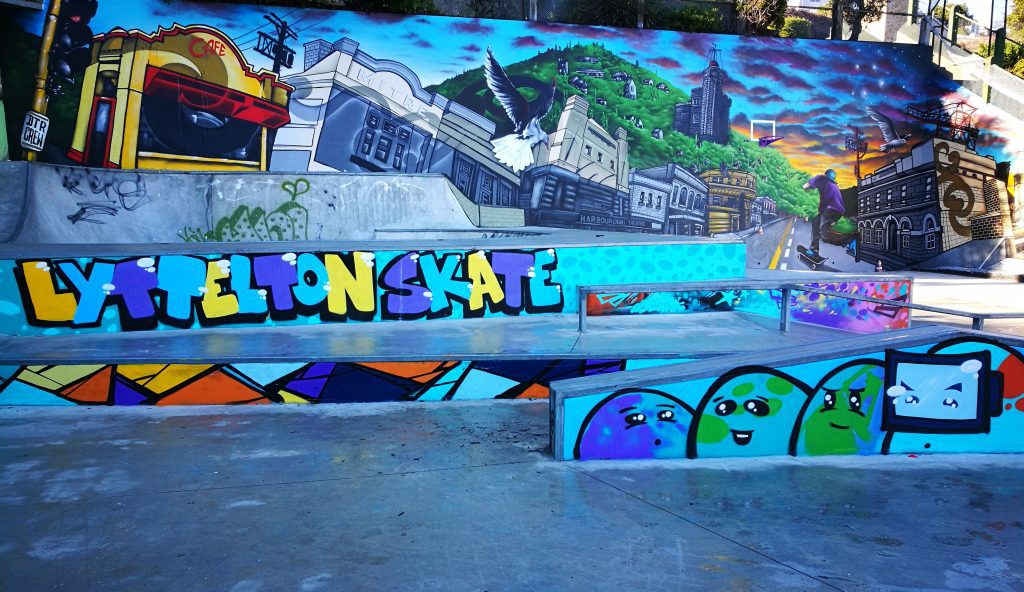
When did you leave for Los Angeles?
I left in 2008, during the global recession. (Laughs) I basically landed, and Obama was elected. People were crying and shit. It was pretty amazing to be in the United States for something like that, at that time, and to be part of it, to feel like you were a part of it. But being there wasn’t easy in the beginning, I was doing a lot of construction work, there weren’t a lot of opportunities. I was sort of working my way up, meeting a lot of other artists, painting various little projects. Doing things to prove yourself to people who have already lived and worked in the city for a long time and have their foot fucking firmly in the ground. Slowly but surely, I was able to become a full-time artist over there…
Did you have any connections before you went? Were you down with CBS before you went?
No. I had some good friends of mine who I grew up with in New Zealand, two American guys, whose father was based here through Operation Deep Freeze when they were kids. I grew up skating with them, doing graffiti with them, and they had moved back to the States. They were originally from San Diego, and one of them was, actually both of them, were in L.A. at the time I arrived, so I had two really good friends that I hadn’t seen for a really long time to go and start the whole thing alongside. They had already figured out a bunch of shit. To go to Los Angeles by yourself is a big undertaking, and to have someone there as a liaison to help you get through it and figure it out, is ultimate, so I owe a lot to those guys, for sure…
I remember your profile in InForm, the 2007 book produced by Askew featuring a number of New Zealand graffiti artists, you commented on how the Christchurch scene was really small and everyone painted together. That probably highlights how daunting it must’ve been to move somewhere like Los Angeles, which would be like ten or more cities the size of Christchurch…
At least…
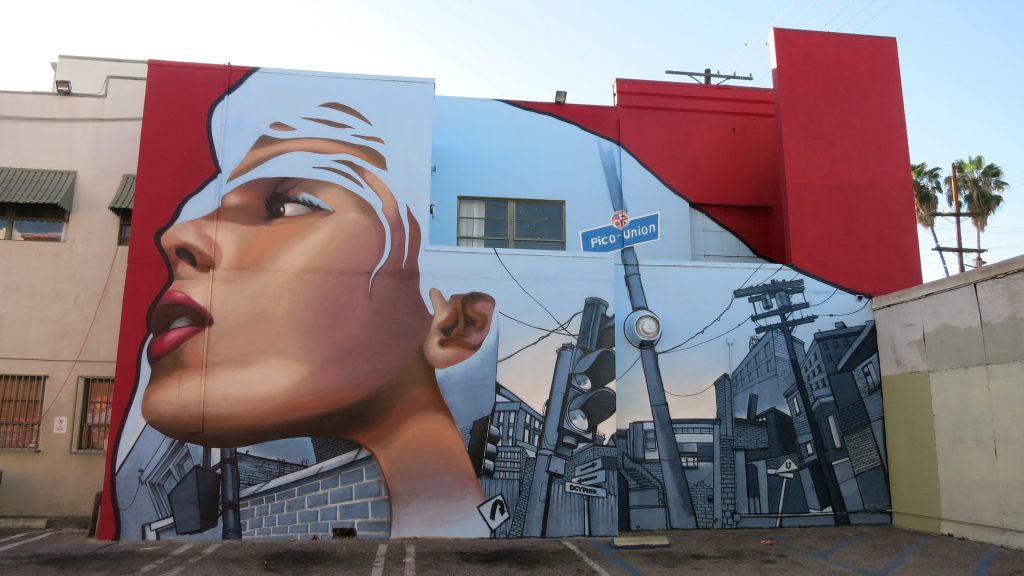
That feeling of starting again, of starting over in terms of reputation, that must have been pretty strong…
Yeah, for sure. But it is refreshing, its humbling to have to work your way back up again. The calibre of work in the U.S. is fucking insane. Just the level of competitiveness is crazy. New Zealand has that kind of tall poppy thing, where if you think you’re better than everyone else, you are going to get cut down quick, you know. Whereas in America, if you think you are better than everyone else, for some reason everyone holds you up on a pedestal.
Do you think that is a unique thing to the United States, something about the mindset there?
It’s a combination of both freedom and capitalism that sort of drives people to do what they do. I mean there are guys in the States who do illegal graffiti and have done illegal graffiti for their entire lives and have never been snatched up, they have refined that shit to an amazing level, where they can go out and produce work without running into too much bullshit. But, at the same time, the competitiveness, you know, it keeps you on your toes.
It is sort of L.A. in a nutshell I guess. It’s a city of contrasts. I imagine anything can happen at any time, in any place…
Yeah, for sure…
Was the American West Coast scene an influence on you coming up? Or were you more inspired by New York and the East Coast, or maybe European writers? An American tourist remarked to me recently, not knowing anything about you, how one of your pieces here in Christchurch looked like something from Los Angeles. Has that West Coast, or more specifically Los Angeles style become more of an influence by living there? There’s that long lineage of ‘West Coast’ artists across a number of fields, and that specifically Los Angeles aesthetic that can be found in music, film, fine art, street art, graffiti…
To begin with obviously it was the New York influence, Subway Art and books like that, before the internet. Then once the internet happened, it was definitely European stuff. I was always more into East Coast hip hop stuff than I was into West Coast stuff, and I kind of liked the grimy, cold aspect of the East Coast. My Mother’s from Boston as well, so I have an affiliation to the East Coast. But once you get to California, and you get a little bit of the lifestyle, it’s definitely influential. It always has had its own style and everything going for it, but my eyes weren’t necessarily open to that. I did see a lot of stuff through magazines and stuff before the internet too, that was all West Coast, but at the same time I wasn’t really thinking about where in the States it was from. When I was young it was just what was aesthetically pleasing. So, I guess it did have an influence on me. There were a couple of guys I remember, like this guy Clown, who had some interviews in some magazines back in the day, who I’ve actually been able to meet since moving to the West Coast, which is pretty crazy. There were a bunch of other guys as well, and obviously all the CBS guys too. I think the Europeans have always taken what writers were doing in the United States and really pushed it in another direction, in more artistic directions, whereas the States has always kept that illegal, raw sort of graffiti, like you’ve got to keep it the real deal, there’s no using some weird technique, people shut you down real quick with that sort of stuff!
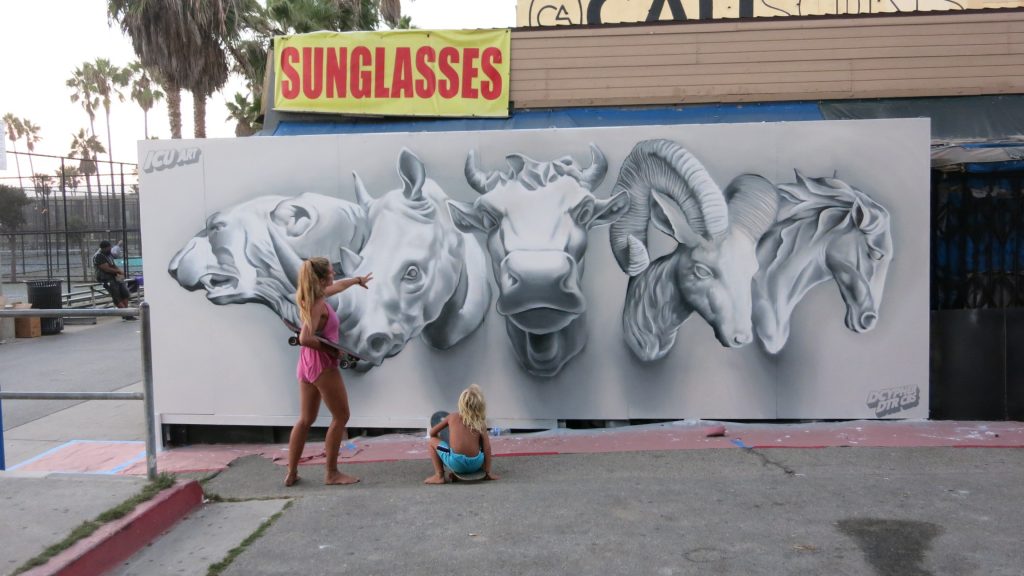
It feels like the Los Angeles influence isn’t only apparent in stylistic terms and letterform traditions, but through the environment itself, it is also evident conceptually and in terms of the imagery you often use. I’m thinking of the architectural elements in a lot of your work, to me, they have the feeling that Los Angeles as a sprawling, built environment, with a certain physical nature, is influential. Do you think that imagery, and even just the conceptual approach to your work, has been a response to living there, to that landscape?
Yeah for sure, obviously as you’re developing your work, you are taking reference photos and stuff like that all the time, and Los Angeles being the insane metropolis that it is, it was kind of inevitable that that was going to find its way into my work, because I’ve always sort of been interested in infrastructure and cityscapes and stuff like that…
Do you see a connection between building letterforms and architectural forms? In terms of how a letter, or a piece, is built up and constructed, it feels architectural in how space is considered, and angles are created and used…
I think earlier on I thought about that a lot. I remember doing some really sort of structural letters that almost looked like buildings in the past. But I do kind of separate my graffiti style from canvasses and mural stuff. It is always in there to some extent, but I try and stick to traditional letterforms, developing it in my own way. I guess always having some sort of architectural element in the background was kind of where I started pulling that stuff from, you know, backgrounds for graffiti stuff…
As you get older, when it comes to your letterforms, is there less influence from what other writers are doing and more of a continuation of what you have already developed? That idea of constant refinement, which is something that comes from the compulsion of writing, from repeating a tag ten thousand times, to perfecting a certain signature letter? For you, is your style becoming more and more insular as you get older, entangled in your own history of writing, more so than really taking notice of other sources?
Yeah, for sure. Like maybe from guys I initially painted with, but with any outside source, it’s not a good look to be doing that. Like you say, you do a tag ten thousand times, fifty thousand times, and over time you start to understand how everything fits together, it’s like an ongoing puzzle, within your own mind. It just refines over time. There are certain aspects that you might see another person doing, but it’s probably more technique than it is style. Because with style, it is hard to adapt someone else’s style, you are always going to have your own style, it’s almost impossible to reflect another person’s style, but technique for sure…
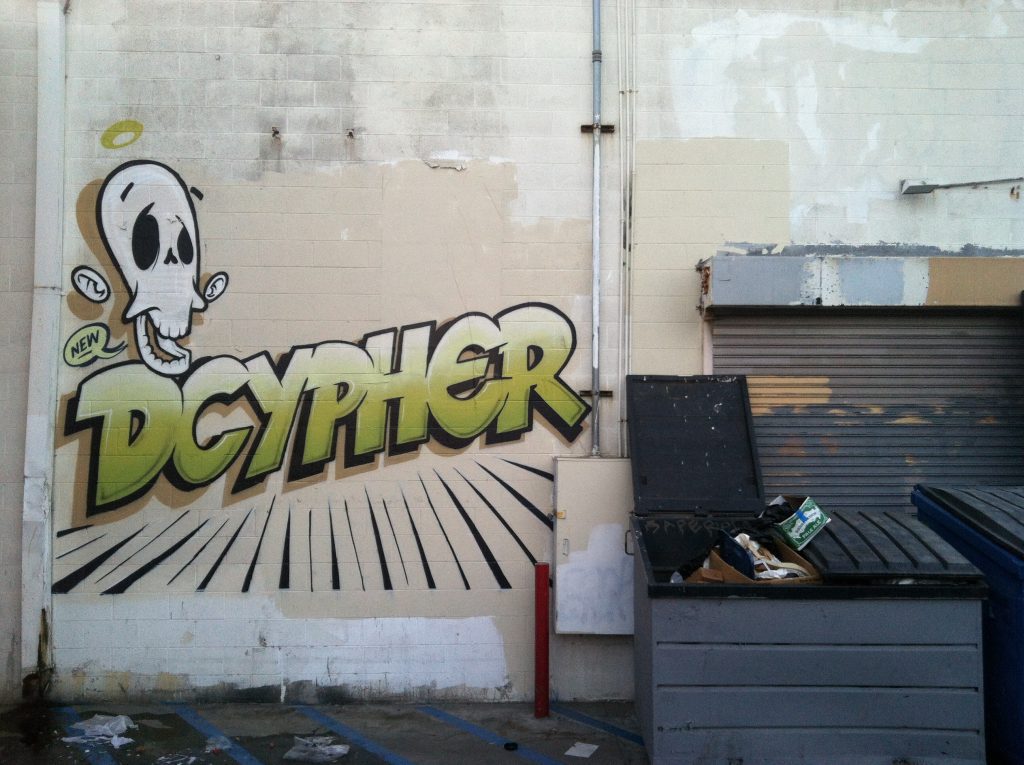
Like you were saying earlier, that from the pre-internet era, there were the influences of Subway Art, Style Wars, and there was what was on the walls around you, those influences were what you had, now with the digital age, you can see all these different styles, you can see writers from all over the world, in some ways it must be harder to develop a personal style amongst so much information…
Yeah…
Because so many things have been done, but also, you’ve seen all those things as well. You are nowhere near as isolated. Of course, that isolation meant that some really interesting local styles developed as a mixture of certain influences, like in Brazil, with the combination of hip hop graffiti with pixachao, or even Los Angeles and the influence of Cholo graffiti, but it is getting harder and harder to even see that happening because everything is available to everybody, everything seems more global.
Yeah, I think that graffiti has always had regional styles too. You could pick someone’s style from where they were in the world, even with the internet you could pick someone’s style; if you understand graffiti, you know someone from the West Coast of America as opposed to someone from the East Coast, versus someone from Brazil, versus someone from Australia, to some extent. Graffiti has always had its own specific styles, even within countries, it’s sort of like, ‘oh this is more of a northern style or a southern style’, which is awesome. It means the direct influence of what you are seeing in real life is what really has impact on your style, rather than seeing awesome photos on the internet all day long, which won’t ever have as much impact as walking up to a wall of a legend dude who has been painting twenty years in your city and just being like ‘Holy shit! That’s insane!’
To be continued Homecoming (Part Two)…
In the meantime, check out Dcypher’s various platforms:
Facebook: https://www.facebook.com/dcypherart/
Instagram: https://www.instagram.com/dcypher_dtrcbs/
Web: https://www.dcypherart.com/



